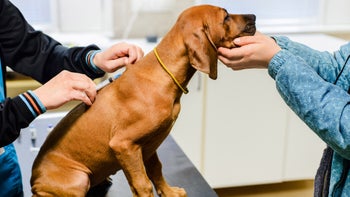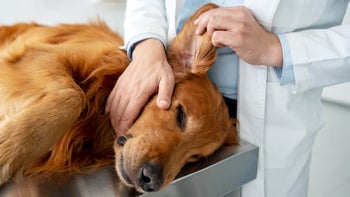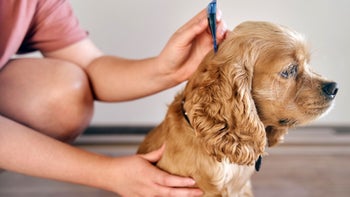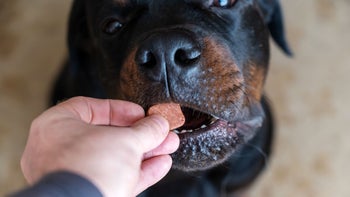
How to Clean Your Dog’s Teeth at Home, and When to See a Vet
Key takeaways:
Dogs can develop dental issues like gum disease that can affect their overall health.
You can brush your dog’s teeth at home to help support their dental health.
Professional teeth cleanings are also an important part of your dog’s dental care.
Table of contents
Just as we brush our teeth and go to the dentist, dogs also need dental care. Brushing your dog’s teeth regularly can help prevent health issues like gum disease. It can help keep your dog comfortable too. Professional teeth cleanings at the vet are also important.
Read on to learn why teeth cleaning is great for your dog’s health and what you should know about professional cleanings.
Why should you have your dog’s teeth cleaned?
Jamie Richardson, BVetMed, the head veterinarian at Small Door Veterinary, said that a dog’s dental health also affects their overall health.
Search and compare options
“Just like humans, dogs and cats get plaque and tartar buildup on their teeth and over their gums,” she said. “Over time, this can lead to oral diseases like periodontal disease [gum disease] and gingivitis.”
These dental diseases can be painful. They can also cause inflammation, tooth decay, and tooth or bone loss. It’s also possible for plaque and bacteria to enter your dog’s bloodstream. If that occurs, the plaque and tartar can affect your dog’s heart, liver, and kidneys.
Cleaning your dog’s teeth can minimize plaque and tartar. This helps keep your dog’s teeth healthy and supports their overall health.
Do dogs get cavities?
Yes, just like people, dogs can get cavities. It’s not as common as it is in humans, but it does happen. Cavities develop when bacteria from food builds up on teeth. This buildup creates an acid that weakens and erodes tooth enamel. The result is a cavity.
How often should you clean your dog’s teeth?
Richardson suggested brushing your dog’s teeth regularly. “Ideally, owners should clean their dog’s teeth once per day,” she said. “However, if your dog won’t tolerate that, anything is better than nothing.”
In addition to brushing your dog’s teeth at home, professional dental cleanings help remove the tartar that you can’t remove by brushing. During a professional dental cleaning, your dog will receive an examination and teeth cleaning and polishing.
Mite fright: A mite infestation can be fatal for dogs if it’s not treated. Here’s what one dog mom did to save her poodle.
Hormone help: High-protein foods and smaller meals can help manage your dog’s hyperthyroidism. Follow these dietary guidelines.
Soothing stiff joints: Dogs may not move as flexibly as they age. Try these medications and home remedies to ease your dog’s arthritis symptoms.
During the cleaning, a vet will remove plaque and tartar. They will clean above and below the gumline on both the inside and outside of the teeth. These are areas that you can’t access with a toothbrush. That’s why it’s important to keep up with both brushing teeth at home and professional cleanings at the vet.
Dog teeth-cleaning tools to use at home
To clean your dog’s teeth at home, you’ll need an appropriate toothpaste and toothbrush. Human toothpaste is toxic to dogs. Instead, buy a toothpaste that’s designed for dogs.
You can also find pet toothbrushes and finger brushes at pet stores. Depending on your dog’s size, a human baby toothbrush may also work well.
Read more like this
Explore these related articles, suggested for readers like you.
If your dog doesn’t like brushing with a toothbrush, you can use a piece of gauze. It’s not as effective as a toothbrush, but gauze can still help remove plaque and bacteria. You can wipe the piece of gauze over your dog’s teeth 2 to 3 times a week to help maintain their dental health.
How to clean your dog’s teeth
If you introduce teeth brushing gradually and in a positive way, many dogs learn to accept it. It’s ideal to start this habit when your dog is a puppy. But adult dogs can also learn to have their teeth brushed.
Richardson recommended a gradual method of introducing teeth brushing:
Start by letting your dog taste a little bit of the toothpaste. Then put some toothpaste on your finger. Rub your finger on your dog’s teeth and gums. It may take your dog a week to a month to get used to this process.
Once your dog accepts your finger with the toothpaste, start using a piece of gauze. Gently rub the gauze against your dog’s teeth to get them used to the rubbing feeling.
Next, try using a toothbrush. Gently lift up one side of your dog’s upper lip, then brush in small, circular motions. Brush only a few strokes at a time, then stop and praise your dog. Repeat this process until you’ve brushed the outside of all of your dog’s teeth.
This can be a slow process, and it’s important to be patient with your dog. If your dog gets agitated, stop. In the beginning, you may need to brush just a few teeth at a time. As your dog gets more comfortable, you’ll be able to brush more teeth each day.
Do dental treats keep your dog’s teeth clean?
In pet stores and on pet retailer websites, you’ll find many dental products. Dental chews, treats, foods, supplements, toys, and water additives are all marketed as being good for your dog’s health. But are they?
Richardson said that the majority of dental products are not scientifically proven to be effective. She recommends reviewing the Veterinary Oral Health Council’s list of dog dental products. The products on that list have been proven to be beneficial to your dog’s health.
If you buy dental treats or other products, keep in mind that they’re not a substitute for good dental care. Use those products in addition to, but not to replace, brushing your dog’s teeth.
How often should you see a vet for a professional dog teeth cleaning?
How often your dog needs a professional cleaning can vary. Many pets need a professional cleaning every 6 to 12 months. Several factors can affect how often your dog needs a cleaning, including:
Age: Older dogs tend to need more frequent cleanings than younger dogs.
Breed and size: Smaller dogs and breeds tend to need dental cleanings more often than larger dogs. Smaller dogs have small mouths that can cause their teeth to be overcrowded. That overcrowding can lead to more tartar buildup.
Lifestyle: Lifestyle factors, like the food your dog eats and whether you brush their teeth at home, can affect how often your dog needs professional cleanings.
A vet can provide advice about your dog’s teeth-cleaning needs. They will sedate your dog before performing a professional teeth cleaning. They can clean more thoroughly than you can at home. Be sure to ask the vet about your dog’s dental health during their annual checkup.
Does pet insurance cover the cost of dog teeth cleaning?
According to Richardson, pet insurance typically doesn’t cover the cost of dental cleanings. Some plans may include dental cleanings as part of a wellness package. Sometimes, the cleanings are covered up to a set amount each year.
Some pet insurance plans may include coverage for dental issues that are caused by a specific injury, like a broken tooth after your dog chewed on a stone. Check the fine print of your policy so you know exactly what’s included.
The average cost of professional dog teeth cleaning ranges from $100 to more than $700, depending on your dog’s needs. If your dog has a dental disease, expect to pay around $500 for treatment on average. Keep in mind that a dental cleaning requires anesthesia and predental blood work. These will typically be additional costs on top of the cleaning.
Frequently asked questions
If your dog won’t let you brush their teeth with a toothbrush, try using your finger. Squeeze a small amount of canine toothpaste on your finger, then rub your dog’s teeth. You can also try this with a dental wipe wrapped around your finger. Do this daily until your dog accepts it as part of their routine. And be patient — it may take a few weeks or more before they’re comfortable.
There’s no research to support using apple cider vinegar to clean your dog’s teeth. It’s best to get a veterinarian’s advice on the best teeth-cleaning products for your dog.
Your dog will probably develop gum disease if you never brush their teeth. Gum disease is caused by plaque buildup on teeth above and below the gumline. It can lead to gum inflammation (gingivitis) and tissue damage (periodontitis). Dogs with gum disease often experience bad breath, discomfort, pain, and tooth loss.
The bottom line
By caring for your dog’s teeth, you’ll also be caring for their overall health. Regularly brushing your dog’s teeth can help minimize tartar buildup and prevent issues like gum disease. Pairing good dental care at home with professional teeth cleanings at the vet can maximize your dog’s dental health. It can also help you avoid expensive and painful health issues later.
Why trust our experts?



References
American Veterinary Medical Association. (n.d.). Pet dental care.
Bauhaus, J. M. (2024). How much does cat or dog teeth cleaning cost? CareCredit.
Bellows, J. (2013). Brushing your dog’s teeth. Veterinary Partner.
Bellows, J. (2024). Practical dental care tips for dogs and cats. Veterinary Partner.
Cornell Richard P. Riney Canine Health Center. (n.d.). Periodontal disease.
Hale, F. A. (2009). Dental caries in the dog. The Canadian Veterinary Journal.
Small Door Veterinary. (n.d.). Dr. Jamie Richardson (she/her), BVetMed, USDA accredited.
Veterinary Oral Health Council. (2023). VOHC® accepted products for dogs.





























